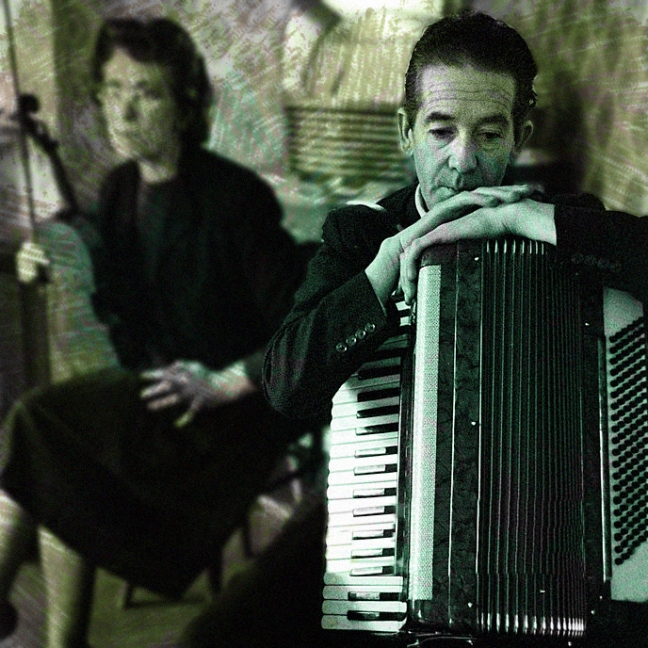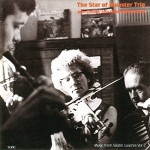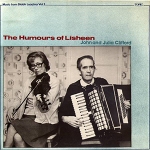John Clifford (1916-1981) grew up as a neighbor of the Weavers of Lisheen. Like the Weavers, his own family was deeply imbued in the music: his parents and siblings all played or danced or sang, so it was inevitable he would pick up the music from an early age. He played whistle in Bill Murphy’s fife-and-drum band, but he soon gravitated to the button accordion. His first tutelage came from his older brother Tim, but as he progressed, he was sent to learn from Pádraig O’Keeffe.
As a young man he was Denis Murphy‘s first musical partner. In John’s words: “Denis was working over in Co. Cork or something for a while you know, and he came on holidays or something… I don’t know whether he heard the music out in the road or not and he came in and he had the fiddle… he couldn’t get over it. I played the reel called The Broom… God he was delighted, he thought ‘Now I got a companion now and I got a mate who can play.’ And then we started. Every week one of us’d go down to Killarney. We’d get into D.F.O’Sullivan’s or Hilliard’s and get one record. We made up a collection of’m. We’d every one that Coleman made… Morrison, Killoran, Paddy Sweeney…” Around 1933 the pair began playing in local dance halls where they soon earned the admiration of the dancers and other local musicians.
It’s unclear what sort of training he received from Pádraig, but at least as far as technique on the two-row box, he seems to have been largely self-taught. He was playing on an instrument tuned D/D# and played from the inside row. This gave him the options for ornamentation and phrasing available to the modern C#/D player, but had the somewhat unfortunate result that what he played came out a half-step sharp from concert pitch. Denis would be forced to tune the fiddle up to play with him, often resulting in broken strings to Denis’ consternation. Despite this drawback, John became regarded by many as the best box player in Sliabh Luachra at this time. He was invited to perform on a number of occasions on the radio, and Johnny O’Leary, when he began on the box, came to John for lessons. In later days, and long after John’s death, Johnny would extol the virtues of John Clifford to any visiting box player who would listen. The story goes that Johnny would bend the ear of the great Joe Burke about him any chance he got. One day Joe asked Johnny ”but, was he really that good?” And Johnny was said to reply: ”You’re lucky he’s dead from you, Joe!”
As with so many others, the economy of the day forced John to emigrate to London in 1938 in search of work. Upon his arrival, he looked up his former neighbor and friend, Julia Murphy, who had moved to London not long before. She was able to find him work as a porter in the hotel where she cleaned for her own living. She had already begun playing music at some of the smaller London dance halls in various groups and combos. John, who had apparently sold or otherwise lost his old instrument in one way or another along the way, bought a new button accordion and joined Julia at one of these early dance hall gigs. To his surprise and dismay, this new box was tuned to a different system and his usual fingering made it impossible to join in with the other musicians. He also soon realized that these dance hall bands were sometimes called upon to play other types of music in a variety of keys, and that the free-reed instrument of choice amongst the local squeezers was the piano accordion. He took the ambitious and fated step of purchasing and learning this new instrument, which on the one hand made it possible for him to enter the dance hall scene, but also would change the sound of his music for good.
The piano accordion, being a unisonoric instrument (playing one note per key regardless of the bellows direction) does not lend itself to the bubbling staccato quality of Irish dance music, and even less the particular drive of Sliabh Luachra polkas and slides. Perhaps there is a kinship of sorts between the rapidly changing direction of the fiddle bow and the similarly rhythmic press and draw of the button box played along the row? In any case, the piano accordion player must exert extra energy and skill to counteract the inertia of the larger, more massive instrument. It seems John Clifford was unaware, unable, or simply unwilling. In any case, upon switching instruments, his playing became more versatile and louder no doubt, but comparatively lethargic, dragging, and muffled.
Despite these qualities, John was able to find work as a musician with his new musical partner Julia. They hit it off musically and personally, and in 1941 they were married. They soon had two sons, John Jr. and Billy, and the young family settled in the Cricklewood area of London.
In their early days in London they both worked at a variety of day jobs,and played in a variety of bands and combos at night, playing a mix of traditional tunes and other popular dance music as the tastes of the day demanded. In 1953 homesickness seems to have got the best of them and they moved back to Ireland, first to Lisheen, and then to Newcastle West in Limerick in search of better opportunities and perhaps a return to the faster pace of life they left behind in London. It was here they formed the Star of Munster Ceili Band with the Moloneys of nearby Templeglantine: Pat Moloney on button accordion and fiddle, Liam Moloney on banjo, and Biddy Moloney on the piano, with percussionist Paddy Murphy. Julia’s brother Denis would sometimes sit in, as did young Billy who was developing his skill on the whistle. For a while they were one of the highest rated and most sought-after ceili bands in the southwest of Ireland, playing dances throughout Limerick, Kerry, Clare, and Galway. They also made two radio broadcasts from Dublin. Despite the band’s popularity, it was a source of stress for John, as he assumed the roles of both bandleader and agent, traveling the countryside to book engagements, arrange for transportation and lodging, and all the other minutia that goes into professional performance. In addition, he was never able to make the economics of the enterprise work out, and expenses outstripped income more often than not. After two years the ceili band called it quits.
In 1958 the peripatetic Cliffords returned to London. At first they went back to playing in the dancehalls, now with Billy on concert flute as a full-fledged member of the group, but it was just as the popularity of the dancehalls was beginning to wane, and John quickly realized they’d need to find new venues for their music. With the decline of the dancehall scene came the rise of the Irish pubs in London, where nightly performances and sessions of traditional music were coming into vogue. The scene was different than what they were used to, and though John immersed himself in it with gusto, Julia and Billy often as not stayed home to play together in the kitchen. (It was during this period that they began to develop the tightly knit duet playing which would eventually be heard on their album Ceol as Sliabh Luachra.) At times, though, the three of them would secure gigs as the Star of Munster Trio. The London scene now had its own burgeoning local style and repertoire, and the Cliffords found little call for Kerry slides and polkas. Their old music was to some extent abandoned and forgotten (if only for a time) and they soon proved they could play the popular jigs and reels of the session scene as well as any of their illustrious contemporaries.
In in 1964 and again in 1976 the Cliffords committed some of their music to tape, and in 1977, London-based label Topic published two albums: The Star of Munster Trio and The Humours of Lisheen. John lived only a few more years, but his legacy lives on in these recordings and the memories of his family, friends, and those who danced to his music.
Learned from: Pádraig O’Keeffe
Taught: Johnny O’Leary
Played with: Denis Murphy, Julia Clifford, Billy Clifford
Recordings:









Great to see this. My grandad was Johns brother Tim.
LikeLiked by 1 person
As far as I know my grandmother Jimmy was John’s older brother.
LikeLiked by 1 person